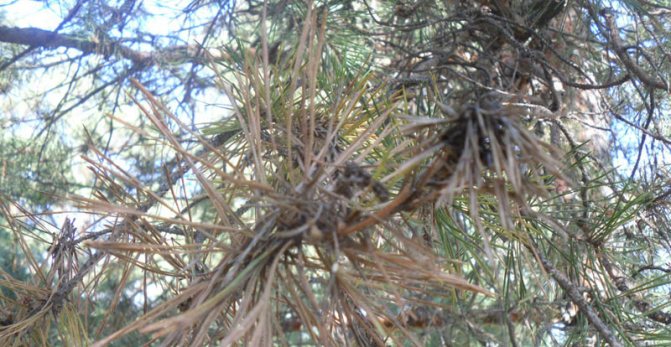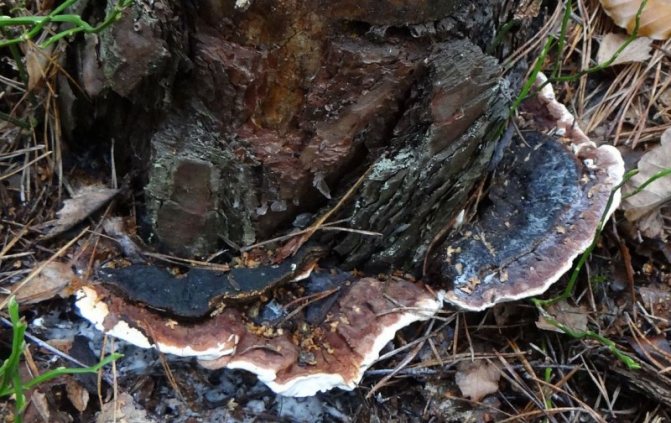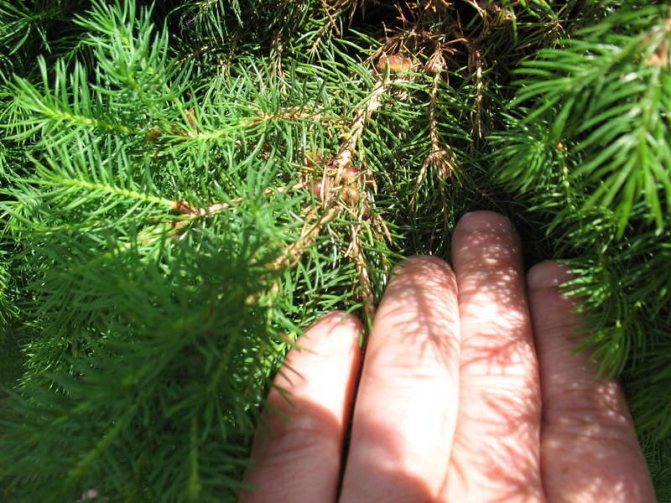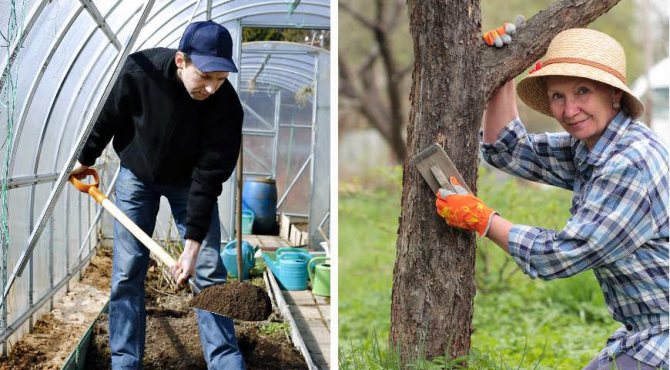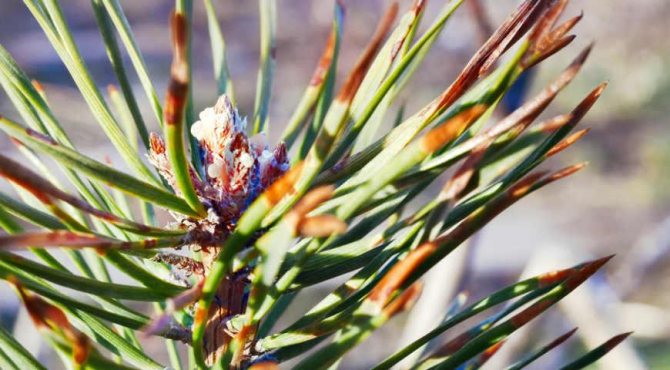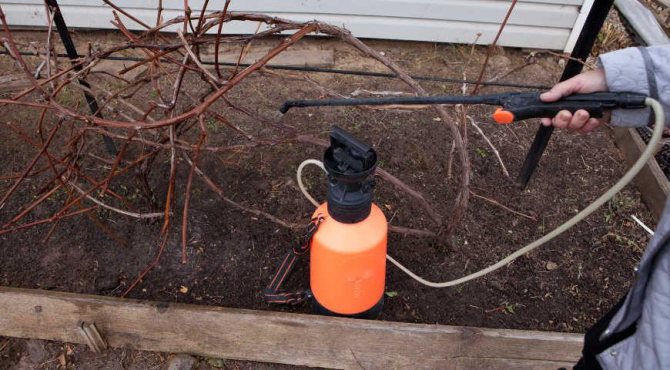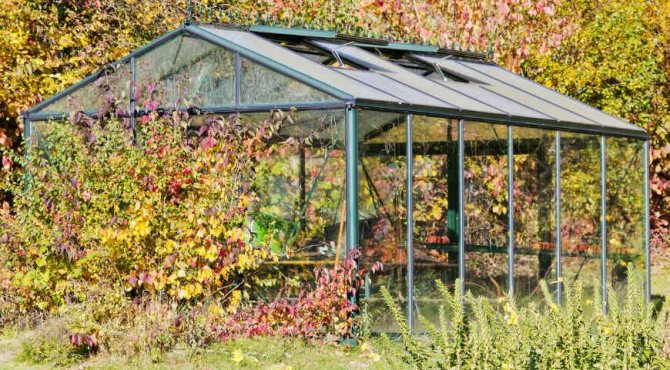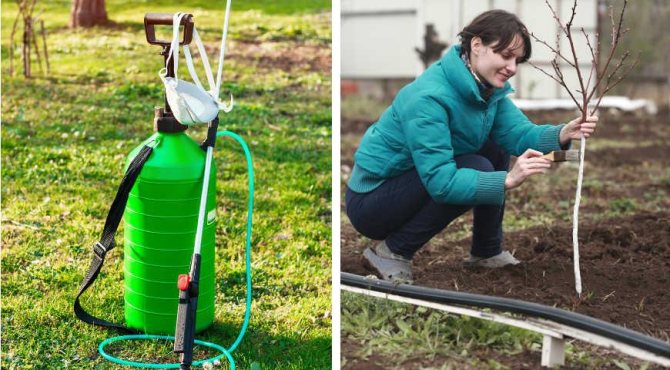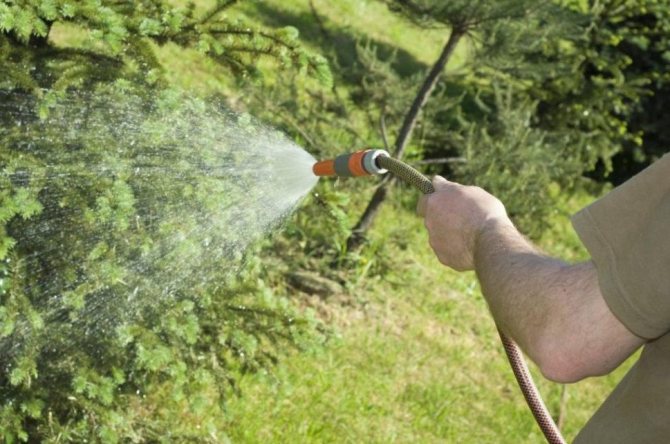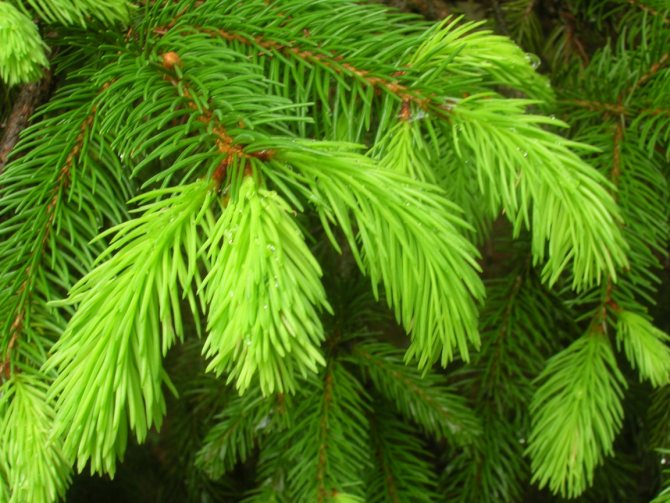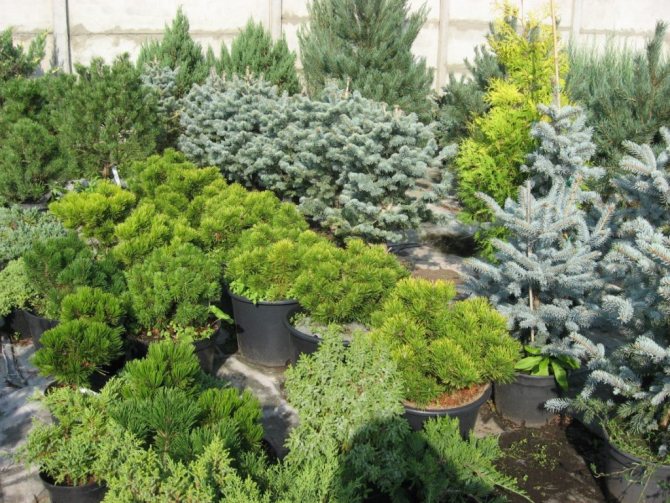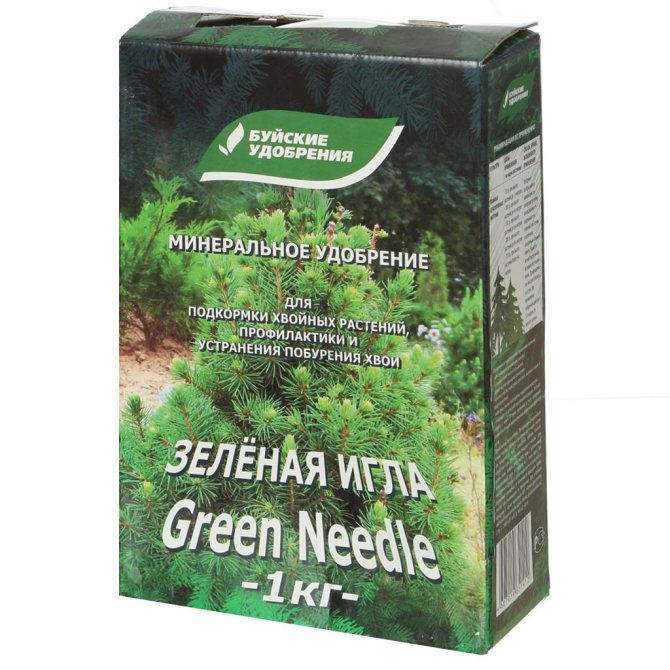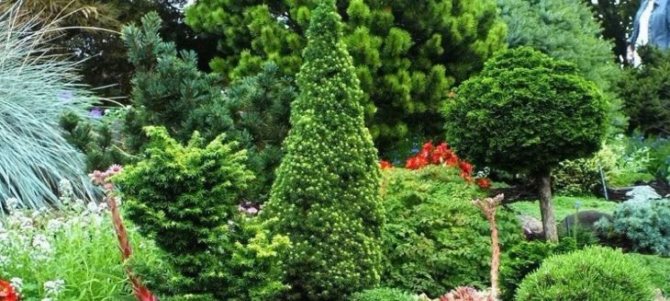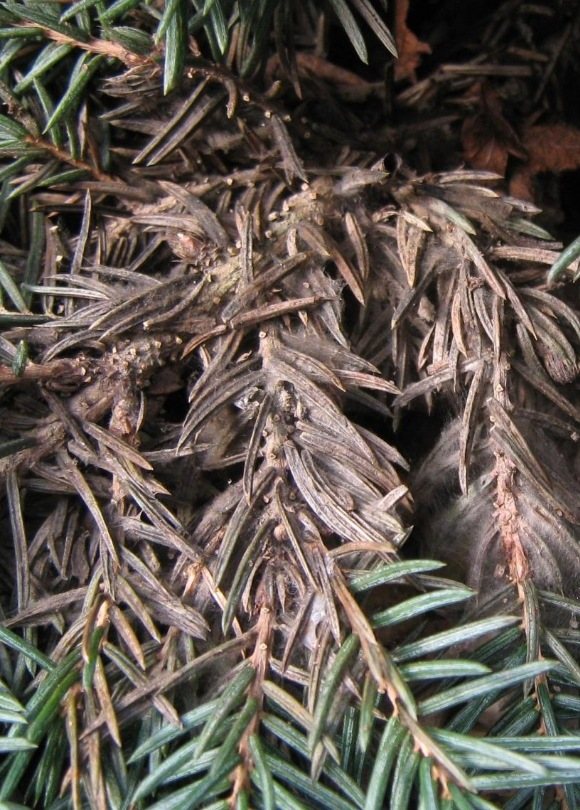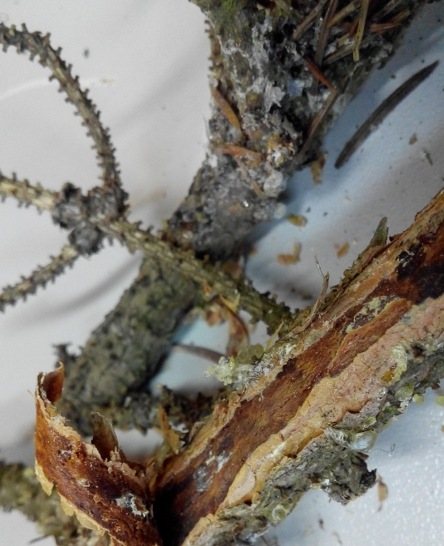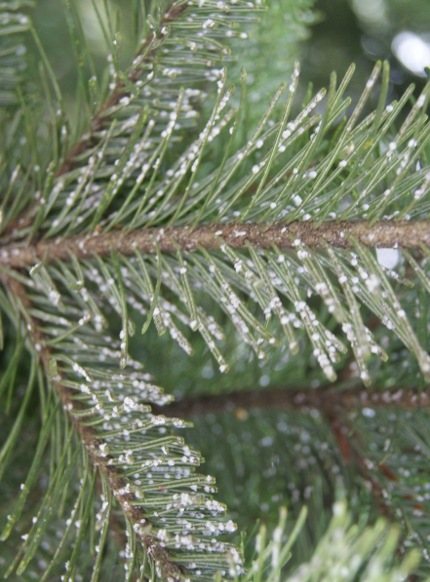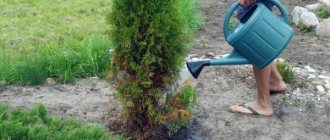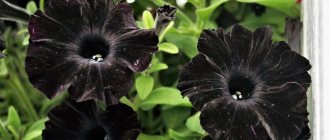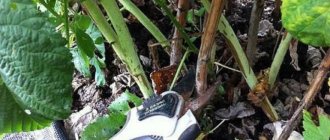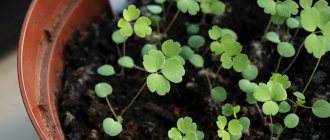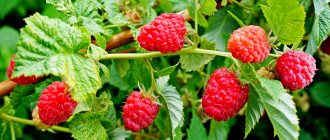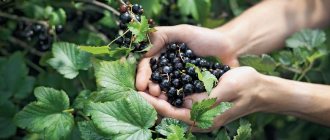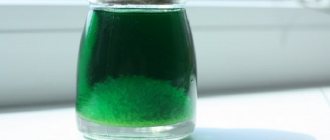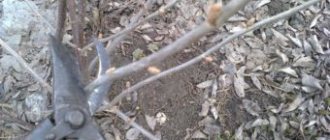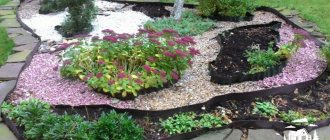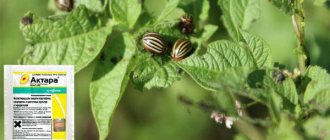Coniferous shrubs and trees are an original and special decoration in gardens. Recently, the use of green plants in design planning near water bodies, the creation of hedges, etc. has been in special demand. The advantage of conifers over deciduous trees is their durability and reliability. You can admire the beauty of flowers only for a short period during the summer, and enjoy the green color and fresh scent of coniferous resin - in winter, spring, autumn and summer. Conifers in compositions together with other garden trees look very beautiful, but autumn is the period when you will need to worry about them to some extent. Like all plants, conifers need fertilizers for rapid growth: such top dressing will keep your plantings decorative throughout their life. Of course, you can use universal fertilizers for conifers, but preference should be given to special ones. You will learn about the composition and methods of using the most effective of them on this page.
Fresh articles about garden and vegetable garden
Ever-flowering begonia: planting and care in the open field
When can you ferment cabbage in December 2019
How to prepare grapes for wintering in the Middle Lane?

Getting rid of yellowed needles
Before sending conifers to hibernation, it is necessary to free them from yellow needles.
To do this, we put on gloves, thereby avoiding needle pricks. Gently peel off dry yellowed needles from the tree, which easily come off the trunk and branches.
The work is meticulous, because it is necessary to get rid of all the yellow debris that accumulates in large volumes inside the crown. These activities contribute to the better development and growth of the plant, as well as the reduction of diseases. After work, all garbage must be collected and burned.
Which is better - organics or minerals?
For firs, mineral dressings are more useful than organic ones, but it is only important to select them correctly, observe the timing and order of application.
It is forbidden to fertilize the land with clean manure. You can not water the spruce with a solution made on its basis. Organic matter contains a lot of nitrate, it has a high concentration of nitrogen. These substances have a detrimental effect on spruce.
Infusions made from green grass are also high in nitrogen. They are widely used by summer residents to fertilize the soil, but they are harmful to conifers. Instead, you should use vermicompost and compost.
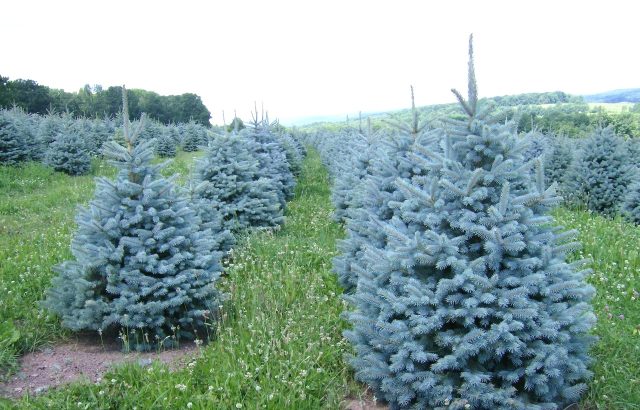

Conifers need trace elements
Fungal diseases (prevention)
For preventive maintenance, we use the drug "Fitosporin", which will appeal to opponents of chemistry. We breed according to the instructions, after which we spray conifers according to the following scheme.
- We begin the initial processing from the inside, that is, from the very thick of the needles collected from the trunk, gradually moving outward.
- You can also use a Bordeaux mixture. Prepare a solution (1%) by diluting 100 g of the drug in 10 liters of liquid.
- We organize the processing of crops when the temperature is above zero.
- Protecting from pests
About a week after treatment for fungal sores, we begin to protect against pests. The drug "Iskra" / "Aliot" / or any analogue that we use, following the instructions in the instructions, will help us with this.
When to fertilize ephedra
Unlike many deciduous plants, when planting conifers, it is not recommended to apply fertilizers to the soil, since they promote the growth of vegetative organs and the plant begins to actively build up green mass. And our task is to give the coniferous plant a good root first. This will help drugs such as rooting.


Watering
Ephedra consume moisture even in winter, and with strong freezing of the soil, they may not have enough of it in full.
Therefore, even with a large amount of rain, it is necessary to carry out water-charging irrigation before the first stable frosts. After all, it is very important to give the roots a good drink of water, in order to avoid the death of a tree from dehydration in winter.
6-8 buckets of water is enough for an adult plant. But we do not pour out the full volume immediately, but gradually, stretching the water charge for 1-2 days.
Well, if your site has a fairly close occurrence to the groundwater surface, watering is not necessary.
Popular drugs
Well-known, widespread products that can be purchased in stores.
Florovit
A fertilizer specially developed for conifers, containing a minimum amount of nitrogen, a lot of phosphorus, potassium and magnesium. Autumn feeding with this preparation not only nourishes the plants, but also increases their immunity, allowing them to survive even a fierce winter. Release form - bags, plastic buckets of different weights. The approximate cost is from 620 rubles per 3 kg.


Osmocote
The fertilizer is remarkable for its prolonged action. As soon as the soil temperature drops below +5, the granules stop dissolving. They will continue to operate in the spring. And therefore, when it is introduced in the fall, there is no need for spring feeding. The approximate cost is 500 rubles per 0.5 kg.
Bona forte
Fertilizer is renowned for its economy. One package (5 kg) is enough to feed 200 conifers. In addition to the main macronutrients, it contains silicon and other trace elements. The drug prevents the browning of needles, strengthens the root system of plants. Chlorine free. The average cost is from 419 rubles for 5000 g.
Mulching
It is necessary to organize mulching of the trunk circle with peat or well-rotted compost. Also for these purposes, you can start up the coniferous litter collected in the forest, that is, a layer of rotted earth or bark.
But we collect mulch only from under a pine tree and always a healthy tree. There is no need to drag any infection out of the forest, there is already enough of it on the site.
We mulch with a layer of 3-5 cm. This helps to keep the roots from freezing, as well as to retain moisture in the soil.
Features for plants
All conifers need their own autumn processing: some will not survive the winter without abundant watering, the second without feeding, and others without shelter. Indeed, with all the similarity of care, there are also significant differences.
For pine
Before the first frosts, the root system of newly planted trees is covered with a layer of peat (8-9 cm). In this case, peat plays the role of mulch, which protects from frost and relieves moisture loss. In some regions, young pines are also covered with spruce branches to avoid frostbite of the crown. He will save plants from sunburn at the very beginning of spring.
It is generally accepted that an adult ephedra does not need feeding at all. In the forest, it serves as humus from fallen foliage, and in the plots - rotted compost. When embedding it in the ground along the near-trunk circle, it should be borne in mind that the pine rhizomes are located close to the surface - they can be easily damaged.
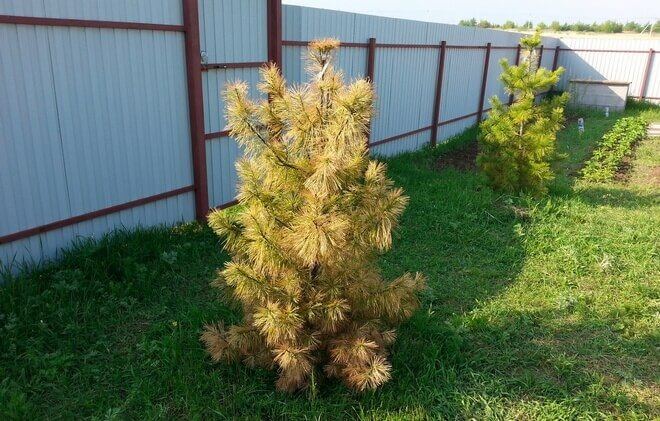

Mineral fertilizers for pine are used once a year, like organic fertilizers. They are usually carried at different periods: if compost is introduced in the fall, then the mineral complex is laid aside for the spring. Or vice versa. There is no fundamental difference here.However, some gardeners are categorical in this matter, preferring to apply mineral fertilizers exclusively in the spring. Usually they are not even bred, but simply scattered around the tree and watered abundantly with water.
For ate
Spruce also needs preparation for winter. But, in addition to peat, the tree trunk circles can be covered with non-woven fabric or kraft paper.
Adult plants do not need feeding if there are no external signs of starvation. After all, they practically do not grow until 6 years old, and therefore consume little nutrients. For them, special growth stimulants are suitable, as well as complex formulations, which are advised to be used no more than 1-2 times a year.
Top dressing is needed after 7 years, when the tree begins to grow up to 0.5 m per year. If a forest spruce grows on the site, and not a decorative (dwarf) one, you should not overfeed it, so as not to spoil the entire landscape design. Gardeners note that with a poor diet, such spruces grow for no more than 3 years, then a beautiful, fluffy crown is formed.
Protecting from snow and sun
In such representatives of conifers as thuja and juniper, from the vicissitudes of the weather (wet snow, freezing rain), the branches disintegrate in different directions, which can lead to their breaking off.
To avoid this, it is necessary to wrap the crops with a shading net. In addition to the fact that it allows you to maintain the shape of the plant, it also acts as a good protection from the spring sun.
Covering material here is not an assistant to us, since under it the conifers can vanish.
It's all. These are the simple manipulations that need to be done in order to prepare our cultures for the winter period.
Video: How to prepare conifers for winter.
The importance and feasibility of feeding spruce
Fir trees grow slowly, active growth is observed in late spring and in the first half of summer. The main top dressing is done in the spring, additional nutrients are added in the summer and early autumn. A month before the start of the first frost, feeding is stopped.
Young plants need additional nutrients, and there is no point in feeding adults.
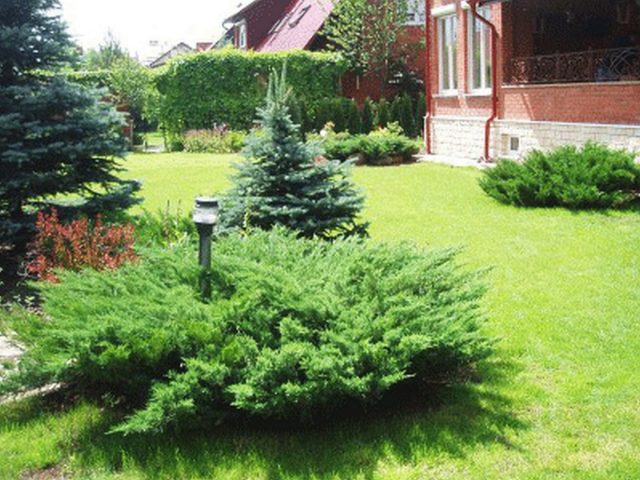

For ate, you need to use mineral fertilizers very carefully
Fertilizers necessary for growing conifers are added to the hole during planting. If, after a few years, their appearance changes, this may signal that they are low in nutrients. Gardeners notice that the needles fall off from the spruce or become dull, sometimes even changing color. Top dressing helps maintain the growth and appearance of trees.
Many gardeners make the mistake of feeding conifers just like apple and other fruit trees. This is wrong, spruce trees need other substances to grow, their dosage should be different.
Conifers need trace elements. They need magnesium, sulfur and iron have a beneficial effect, with the exception of chlorine, which is harmful to them. When choosing fertilizers, you need to take into account their chemical composition.
Care for conifers in autumn
Few in any garden do not grow conifers. These colorful plants sometimes play a key role in garden design, so it is important that they look healthy. Conifers are mostly unpretentious, and knowing this, you can forget about the conditions of detention they need. This is fraught with yellowing of the needles, sometimes so strong that you have to cut out the branches or completely remove the plant.


Winters are especially dangerous for many conifers, after which new yellow branches can be found. Therefore, it is in the fall that we have a chance to create all the conditions in order to see a healthy green plant in the spring.
Selecting and preparing a landing site
Many novice gardeners believe that these trees prefer to grow in the shade, since in natural conditions pine forests are dark, with little access to sunlight. But in home gardens, spruce tends to grow better in a sunny location... The tree grows faster, forms a correct crown and looks healthier than in the shade.
Important! When choosing a site, pay attention to the color of the needles of the tree. Ate of dark tones grows normally in the shade, light ones prefer sunny areas.
Choose a location with good drainage... Excess moisture can kill the plant. The earth should be light and breathable. Before planting, the site must be dug well, weeds must be removed.
The soil should be with a certain level of acidity - 4.5-6 pH... If this indicator is higher, then bacteria begin to actively develop in the soil, which can significantly reduce the growth rate of the tree.


Conifers in autumn
Undoubtedly, many gardeners and amateurs note the high popularity of unpretentious and beloved by all conifers and plants. Not only do they remain a decorative adornment of your garden all year round, conifers differ in a variety of shapes and colors, and they are also not difficult to care for.
Conifers in autumn Looks good in compositions with other trees in the garden, but fall is a time to worry about your "evergreen friends".
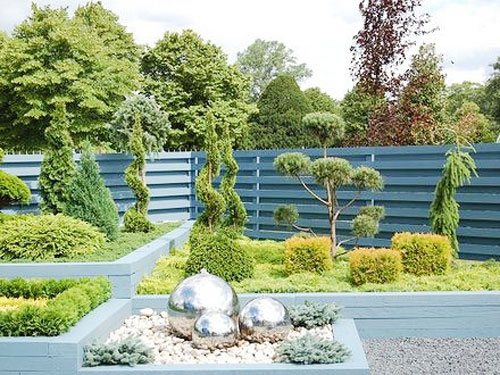

Firstly, conifers in autumn may need sufficient watering. Most coniferous stands (for example, spruce) have a large and dense crown, as a result of which moisture is poorly permeable. Sometimes, despite the heavy rain, there may be completely dry ground under the spruce.
Therefore, especially if the autumn turned out to be dry and not rainy, you should ensure sufficient watering, because conifers evaporate moisture until the frosts themselves and may subsequently suffer from drought and burns.
During winter thaws or spring warming, conifers actively evaporate moisture, while their roots may still be in the frozen ground, which prevents the plant from replenishing moisture. Take care of this in advance, before the onset of cold weather (October-November).


Secondly, conifers in autumn need protection from pests such as fungal diseases and parasitic insects. Such pests can weaken the plant before the onset of winter and cold weather. That is why, at the end of summer and at the very beginning of autumn, one should not neglect specialized preparations that protect coniferous plantations.
However, feeding with nitrogen-containing fertilizers, as well as the treatment of conifers with biostimulants, should be stopped even before the onset of autumn (at best, until August). Otherwise, young shoots will actively continue to grow and will not have time to get stronger or mature before the onset of cold weather.
The roots of coniferous trees can be watered (strictly under the root) with a solution that stimulates root formation. Such a procedure will ensure better development of the root system before the onset of cold weather and winter frosts. You can mulch the trunks with some organic material, which is especially useful and important for young plantings.
The mulch material should be loose and at least five centimeters thick, then it will protect the roots from severe frosts. In spring, the mulch should be removed in order to avoid damping off and allow the soil to warm up quickly.
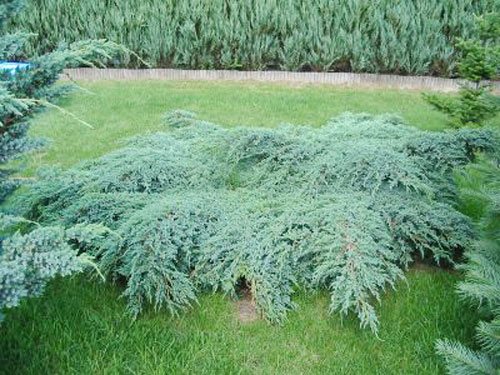

Third, an autumn haircut. Although coniferous trees in temperate latitudes begin to cut in early spring and end in late autumn, note that each conifer plantation has its own periods of active growth, accompanied by abundant resin production. Do not disturb the plants during this period, the intensity of which most often falls in the early spring and summer.
As a result, autumn is the most attractive time for cutting and trimming, especially for beginners.But in such plants as larch, cypress, thuja in the fall, it is advisable to cut off all the broken off yellowed and diseased parts of the branches.
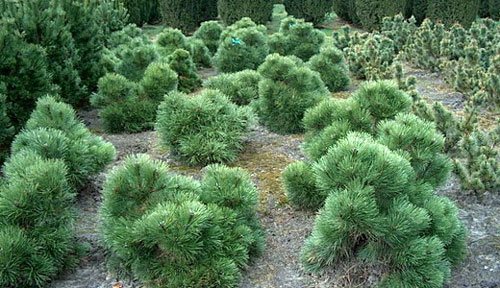

If you cut conifers in autumnthen do not discard the clipped branches. From the cut branches of the spruce, a wonderful "spruce branches" will turn out. This material will serve as an excellent shelter for plants during cold weather.
One of the main advantages of many conifers is that they tolerate cutting well. Conifers grow slowly, so the formation process is not laborious, it is easy to control and direct.
On the other hand, coniferous stands that are regularly pruned sometimes do not tolerate winter well, since they are more vulnerable than freely growing trees.
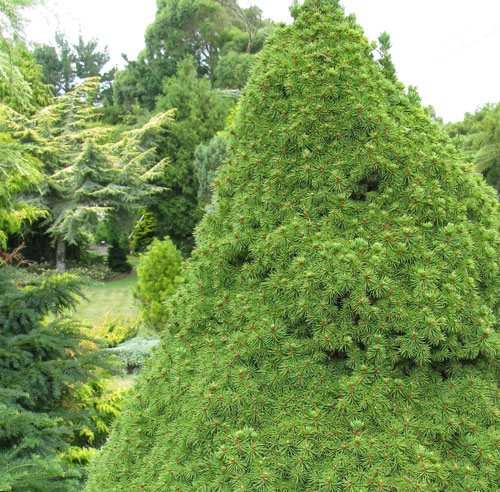

If your area is conditioned by cold and harsh winters, then a shorn conifers in autumn should be covered.
Yes, our "evergreen friends" do an excellent job with cold winters and, moreover, do not lose their unchanging beauty! But the fact that conifers in autumn need our care - this is, perhaps, undoubtedly!
Mineral dressing in the fall
When the needles do not have enough nutrients, re-feeding is carried out in the autumn. It will not harm the garden by adding mulch to the ground near the roots. This precaution will prevent the root system from freezing in winter. It is good when the mulch contains bark, humus, crushed stone, fallen needles.
Superphosphates are ideal for autumn feeding. Fertilizers are spread along the perimeter of the trees and watered. It is not dangerous to feed the ephedra with phosphorus before freezing, since the result from the use of the element is visible only after 5-6 months. During this time, the phosphorus is converted and the root system is ready to consume and absorb the nutrient. It is not worth stimulating the growth of new branches in August or September. From this period, the strengthening of the already grown shoots begins.
Conifers with Pokon: How to Water and Feed Properly
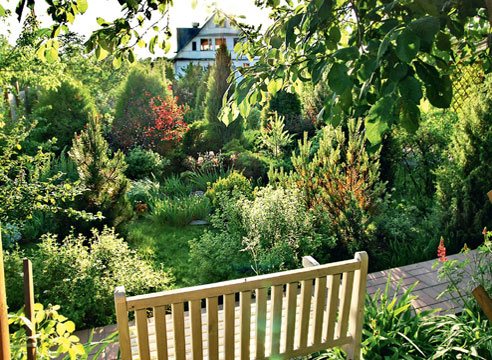

Conifers are ideal ornamental plants. Even in winter, the garden with them is full of life and spectacular. But in order for thujas, pines, spruces, firs, junipers and other conifers to please with the excellent condition of the needles, harmonious development, they must be properly planted, watered and fed.
In nature, minerals are produced in the soil by bacteria. They decompose the organic remains of dead organisms (humus) and release the very compounds of nitrogen, potassium, phosphorus, magnesium and other elements that plants feed on. Nutrients enter the body of each plant in proportion to the amount of water it assimilates, which is vital. With the combination of the "right" bacteria, good humus and sufficient moisture, minerals enter the soil in the proportions that the plant needs. therefore Pokon - one of the oldest companies in the field of plant growing in Europe - produces a specialized fertilizer for conifers, which allows you to properly grow conifers and properly care for them.
How to care for conifers in spring: watering
When the autumn rains end, the evergreen conifers in the garden enter a period of moisture deficiency. Lush needles evaporate a lot of moisture, so the soil should not be allowed to dry out, including in autumn. Other plants shed their foliage for the winter to conserve moisture, but most conifers do not. In late fall, sprinkle conifers well at the root (5–8 buckets per plant). Moistened soil freezes to a shallower depth, which reduces the risk of spring damage.
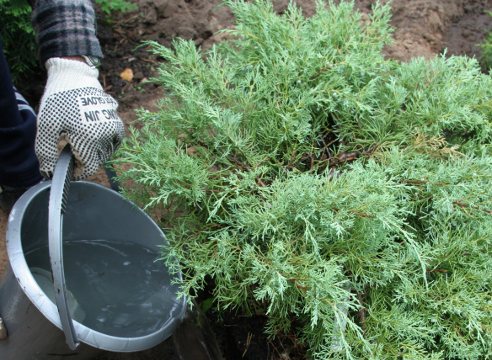

The crown of conifers wakes up early, often when the roots cannot yet provide it with moisture due to frozen soil. Hence, burning needles is a common problem in the middle lane. How can we help plants restore normal living conditions? Noticing this, immediately shade the crown, sprinkling first with water, if the weather is sunny (10-50 liters per seedling, depending on the size).Water coniferous plants with warm water during the warm time of the day so that the water, long before the cold night, has time to completely go into the soil without freezing. If the water spreads without absorbing, then the soil is still frozen. Then water several times a day in small portions. At the slightest risk of frost, watering is canceled! When the daytime temperature steadily rises to + 10 ° C, treat the crown with Epin, Zircon or HB 101.
In the spring, conifers need a lot of water, but not so much that the soil turns into a swamp: from excessive dampness, the roots of conifers get sick. If you have a few conifers on the site and they are not in the best shape, you first need to strengthen the vitality of the plants. This is easy to achieve with the help of fertilizing and proper agricultural technology. Keep in mind that over-watering can be just as harmful to conifers as drought. In general, conifers love watering on the crown, sprinkling. Thanks to sprinkling, the dust is not just washed off: the stomata of the leaves open up, it becomes easier for the plant to breathe, and accordingly all physiological processes proceed more intensively.
How to care for conifers in spring: feeding
The main secret of growing conifers is simple: when the water touches the roots, all the necessary minerals in the right proportions must already be dissolved in it. This is especially important in spring: when plants wake up, their metabolism is accelerated, they need a lot of water, saturated with nutrients, because this is their only food. Conifers are autotrophs, like other higher plants. They are not able to assimilate organic matter and feed only on a weak solution of inorganic compounds of nitrogen, potassium, phosphorus, magnesium and a number of other elements.
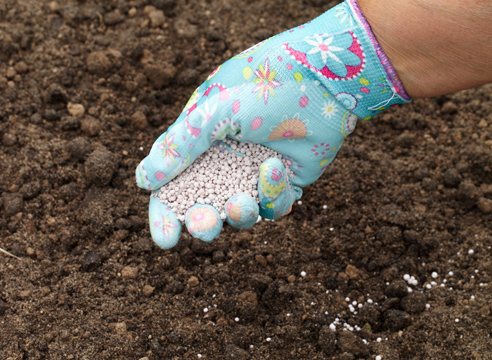

All organic matter is synthesized by conifers from inorganic substances extracted from the soil together with water. Their concentration in water should not be excessive or insufficient. In the first case, the roots "burn", the plants become seriously ill. In the second case, they will also get sick, but already "from hunger" - like any other organism that does not have enough food. In this case, immunity is impaired, therefore infectious diseases will be added to the primary diseases.
Lack of iron in the soil leads to yellowing and even whitening of the needles on individual shoots; with a phosphorus deficiency, young needles acquire a red-purple hue; with a lack of nitrogen, the plants grow noticeably worse, become chlorotic. To grow healthy plants, experienced gardeners use Pokon long-lasting fertilizer for conifers ... Nutrients are collected in granules, covered with a special water-permeable membrane, due to which they gradually enter the soil under the influence of water and heat. Try to scatter the granules without hitting the needles and the trunk, but only within the radius of the trunk circle. The amount of fertilizer is measured according to the instructions on the package. It is enough to apply this fertilizer once in the spring, and until the end of the season, the water of each irrigation will be automatically saturated with nutrients.
Long-lasting Pokon fertilizer contains all the elements necessary for coniferous crops in optimal proportion: both insufficient and excessive concentration of any element is excluded. If complete mineral fertilization was applied during planting, the first feeding is carried out only after two years.
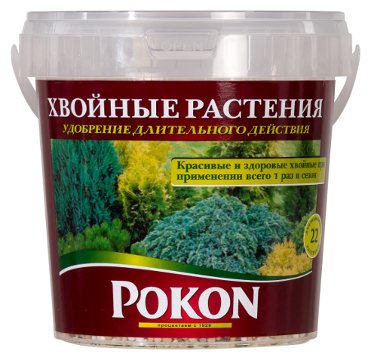

The composition of the granules is balanced Long-lasting Pokon fertilizers for conifers designed for their biological needs; including it contains magnesium, which gives the needles a rich green color. The supply of nutrients in these granules is very large: it lasts for six months. After fertilization, it is advisable to mulch the near-stem circles - with peat, wood chips, bark, compost. This will protect the roots from overheating and drying out in summer and from rapid freezing in winter.
In the 21st century, professional gardening technologies Pokon became available to all people.The correct content of minerals in the water absorbed by the roots creates normal living conditions for conifers. In such conditions, they are able to live without getting sick for tens, and sometimes hundreds of years.
Caring for indoor conifers
But conifers can be grown not only in the garden. It is these plants that will provide clean, fresh air in the apartment. Large cypress, native to California, smells like lemon. Junipers Chinese and solid will take root well on a cool and light windowsill and enrich the air in the apartment with phytoncides. In offices, country houses, in an apartment (for example, in a children's room), conifers perfectly purify the air, improving the health of children and adults. In winter, they can be successfully used as New Year's trees.
Caring for indoor conifers involves moderate feeding, so as not to provoke rapid growth of shoots and to do without frequent transplants.
In an apartment, it is enough to feed coniferous plants once a month with a universal liquid mineral fertilizer. For example, Pokon universal fertilizer for potted plants at half concentration.
The hotter the air in the apartment in winter and the drier the air, the more frequent watering the plants need; care also includes weekly spraying of needles. These plants do not tolerate dry air and high temperatures. From spring to autumn, indoor conifers should be taken out into the garden or on the balcony, shading from the hot sun, because all plants love fresh air.
Foliar processing
It is usually carried out in order to protect the conifers from pests and for external feeding with useful compounds.
To kill harmful insects, as well as their larvae, insecticides are usually used. If the plant is overpowered by ticks, then they take acaricides. In order to eliminate the fungus - fungicides. This is the general name for groups of drugs designed to solve a specific problem.
When processing conifers, you should strictly follow the instructions. Otherwise, following the destruction of pests or diseases, the tree itself will die.
Important! Do not experiment with mixing different drugs. Conifers will not benefit from this.
Processing is prohibited on hot days. The best time for this is late evening or early morning without dew and wind.
In the autumn, you need to have time to make several such treatments. After all, killed pests probably managed to lay eggs, diseases (especially fungal) - spores.
When using any pesticides on your site, you should take care of your own safety (protect your eyes and skin), and also strictly follow the dilution scheme indicated on the package.
Foliar dressing
Conifers are very fond of external nutrient treatment. It is produced by spraying with special devices.
If you use the root method of fertilizing, the plants will be able to assimilate only 20% of the useful elements, with the foliar this percentage rises to 80.
Do not do without foliar dressing in cases with hedges from conifers on the site. They are usually tightly planted and therefore lack food. Foliar dressing can solve this problem. Their autumn use leads to the accumulation of nutrients and favors a successful wintering.
Note. Nutrients, getting on the needles, begin to act already 4 hours after application.
Answers:
Moisture-charging watering is done in October or November, until frosts come and the warm weather has already ended. It (watering) can be avoided if the fall is very rainy. If there is not much or no rain at all, then it is highly recommended to shed the plants well.It often seems to us that there is rain and it has saturated the ground perfectly, but conifers have a very dense crown, and it, like an umbrella, protects the near-stem space from moisture. To create a strategic water supply, water the plants abundantly. The approximate volume of water that is recommended for the crop is about 3-6 lei, depending on the size of your pet. It is necessary in order to fully saturate the plant with water. During the first thaws in spring, when the sun warms up brightly, the lush needles will strongly evaporate moisture into the air. Deciduous branches are bare and the evaporation area is much smaller, and therefore they do not suffer from thaws so much. We can help conifers and make a good supply of water in the fall.
In winter, a coniferous plant does not have enough moisture, since a lot of moisture evaporates (a large evaporation surface through the needles), and in winter moisture does not enter. Therefore, you can do the following: 1. late in autumn water abundantly, spray with EPIN or ZIRCON (this allows you to retain moisture); 2. In the middle of winter, pour warm water over the junipers. 3. wrap the plant with burlap, any covering material will not work, since it transmits ultraviolet light. Preparation of conifers begins at the end of summer. The first thing to take care of is feeding. From August, nitrogen should be completely eliminated, with an emphasis on phosphorus-potassium fertilizers. This will accelerate the ripening of new growth, increase the stability of the root system and have a general strengthening effect. After the leaf of deciduous plants completely disappears, they begin to water-charging watering. This is a prerequisite for a favorable wintering of conifers. The diameter of the irrigation circle should not be less than the diameter of the crown. Moreover, the younger the plant, the more important it is for them to water, since their roots have not yet acquired sufficient strength and can suffer greatly during the freezing of the soil. Increased soil moisture will allow you to avoid this.
It is recommended to mulch the trunks to help protect the root system from frost. In this case, the layer of mulch should be at least 5 centimeters, rather loose. In early spring, it is necessary to remove the mulch to avoid root podoprevanie. It is very important to maintain the integrity of the crown during the upcoming snowfalls and freezing rains. For multi-barrel forms, in order to avoid the collapse of the trunks, they are fixed with a string, without tightening. For horizontal (creeping) species, it is recommended to put stones under the skeletal branches to prevent their deformation under the weight of snow, otherwise the branches will remain curved, the crown will lose its natural appearance. It is stones, and by no means a tree, which in a wet state can become a refuge for various kinds of fungal infections. Young thin-bore "verticals" must be equipped with support stakes, driving them next to the trunk and fixing them on a stretch. Such a measure will prevent the tree from tilting under the weight of precipitation and will protect it from fracture, curvature and eversion along with a fragile root system.
The shelter of conifers is carried out, as it may not sound absurd, not from frost, but from heat and sun. roots in frozen ground are not able to provide the needles with a sufficient amount of moisture. To protect against such troubles, conifers for the winter are shaded with screens from the south side or completely covered with covers. In no case should non-woven insulation or polyethylene be used as a covering material, which are designed to retain heat inside the shelter. Non-woven fabric is less desirable and reliable: it accumulates heat and can cause the needles to dry out. Their use can lead to damping of the crown during a thaw. It is recommended to “cover” conifers with burlap or gauze, which let cold air into the crown.The light color of the shelters also helps reflect the sun's rays, preventing the needles from heating up and coming out of dormancy prematurely. Shelters are removed not earlier than the ground thaws. If, for some reason, winter damage does occur, then when the heat comes, the plants should be helped to restore the damaged areas as soon as possible. The brown needles are sprayed with warm water and shaded with a light cloth. When an average daily temperature of eight degrees is reached, treatment is carried out with biostimulants ("Zircon", "Epin", "HB 101"), which awaken the recovery processes in plants.
Tui and cypress trees may have autumn needles, do not be alarmed - this is normal. Whole branches inside the crown turn yellow and die off. Junipers are not cleaned with individual needles, but with small twigs. In winter, life processes in conifers do not stop, but slow down the flow. Heavy snowfalls can be a difficult test for conifers, wet load settles on branches, causing thin branches to break off and skeletal breaks. When I had such a nuisance, I smeared it with garden var and tightly wrapped it with a special garden bandage, maybe a piece of material. If the plant is covered with a snow cap, you do not need to try to shake it off by tilting the branches. Branches in winter are fragile, careless actions can provoke cracking of the bark. The correct way is to wrap one end of the board with a soft cloth and swing the branches up and down with it. The crown in the access area can be cleaned with a broom or a stiff brush. At my site, I used old broken umbrellas (collected from all relatives and friends) to protect low and creeping conifers. Umbrellas help, I advise! But with freezing rains it is more difficult. The weather more and more often throws up such an unpleasant surprise, the contrast of night and daytime temperatures can cause the branches to be covered with an ice crust. It looks very interesting, fabulous, but it is very difficult to shake off such beauty: the ice is firmly stuck in the needles. To avoid cracks, you need to set up the supports and wait for sunny weather, when the ice melts on its own. Before spring, the February sun can provoke a premature awakening of the roots, and the crown itself can burn. The plant wakes up, and here the so-called return frosts can come. Sap flow caused by unstable weather cannot be prevented, it remains only to minimize the consequences. The crown must be covered with non-woven material or put on potato bags on young plants. We mulch the earth with sawdust to prevent its premature thawing. Light crushed wood will reflect the sun's rays, the roots will remain dormant for some time. With the onset of stable warm weather, the sawdust must be removed, otherwise the plant will begin to rot.
Planting process of conifers
I want to note that an important part of the conifer planting process is digging the planting hole. It should be larger than the root ball of the seedling (20-30 cm deep and 15-20 cm wide). In the finished hole, you need to loosen the bottom to a depth of about 10 cm. If it is in a damp place, make a 5-7 cm layer of drainage in the form of broken bricks. It is worth filling such a hole with a special mixture of soil and peat (ratio 1: 1). I do this gradually, trying to tamp each layer slightly from the edge to the center.
Freshly planted plants should be watered abundantly. I also prefer to roll around the circle around the trunk so that the water doesn't drain anywhere and there is enough room for mulch. Many cultivars of coniferous plants have a superficial root system, so it is worth creating favorable conditions for the growth of such a rhizome. To do this, you need to protect the topsoil from compaction or drying out with wood chips, sawdust, or other mulching materials.
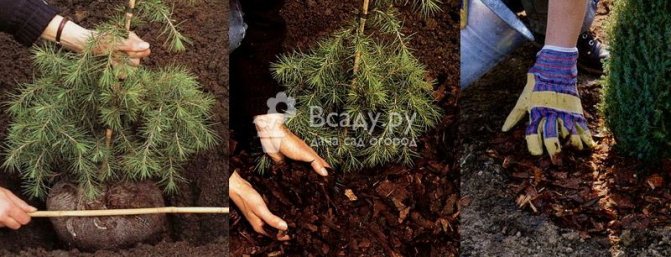

Planting process of conifers
Time of work
Preparation for winter begins from the very beginning of autumn. Conifers are treated for diseases and pests, if necessary, mulch, spill, remove weeds. If we talk about feeding, then it is usually applied twice: in May (during the period of active growth and development) and in August-September.
If you are late with the autumn fertilization, then young conifers will simply have a nutritional deficiency. After all, they will spend a lot of effort on rooting. It is more difficult for hungry trees to survive in winter, they are more likely to die.
If you plan to use liquid formulations, then you should strictly follow the instructions. A highly concentrated solution will destroy the root system. To make top dressing, a shallow circular groove is dug. Nutrient composition is poured there.
If granular fertilizer is used, do not leave it on the surface. It should be embedded in the soil. In parallel with fertilization, dolomite flour is often applied, which not only deoxidizes the soil, but also supplies it with a number of microelements.
Planting of fir trees
Like other coniferous shrubs or trees, it is best to plant spruce in early spring (late April - early May). If the summer is not hot, then it can be planted at the end of August - September.
When planting, you need to maintain the distance between the seedlings. Optimally, this is 2-3 meters. The landing pit should be deep enough - from 50 to 70 centimeters. It must be prepared in advance. At the very bottom, 15-20 centimeters of broken brick are poured, after which a nutritious substrate is added. To prepare it, mix 1 part of sand and peat with 2 parts of leaves and turf. It will be useful to add nitroammophos (100-150 grams) to the substrate.
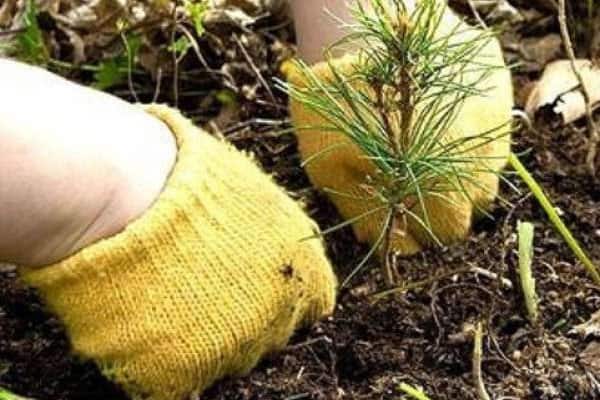

Planting an evergreen tree
When planting in a hole, the root neck of the tree should be at ground level. This important rule must be observed not only when planting, but also when leaving, since the earth can settle, exposing the root collar. After the spruce is planted, it must be watered, and the hole should be covered with a 6-7 cm layer of peat.
Spruce propagation
Spruce can be propagated in a variety of ways. So for species spruce seeds are used, selective species are grown from grafted cuttings. But the most popular breeding method is twigs. They can be cut in spring (late April), summer (mid June or late August) and autumn (November). Picture 8. Reproduction of a tree.
Branches from young trees, aged from 4 to 8 years old, take root best of all. It is necessary to cut them off at the top of the crown, since such cuttings root best of all. The optimum length of cuttings is from 10 to 25 centimeters.
How to properly care for a spruce
How to feed thuja for spring growth
Next spring, thuja needs a comprehensive diet: nitrogen, calcium, phosphorus, potassium, magnesium, iron, etc.
Spring feeding should become a permanent element of care, regardless of the age of the plant. Depending on the climatic conditions of your region, spring feeding is carried out from the beginning to the end of March (the soil should already thaw).
What mineral fertilizers to use
For spring feeding, ammonium nitrate, superphosphates, potassium-magnesium mixtures, calcium preparations and complex fertilizers with a prolonged effect are used. Bone meal has proven itself as a source of calcium - organic matter works great and does not cause harm.
If wintering for young thujas was difficult (they suffered from sun and wind burns, received frostbite), additionally use drugs that stimulate root formation. It could be Agricole, Kornevin.
Can thuja be fed with urea?
Urea is a more aggressive top dressing, its nitrogen content is much higher, plus the decomposition period is longer.For thuja, urea (carbamide) is an undesirable fertilizer; it is much better to use ammonium nitrate.
Spring pruning of ornamental trees and shrubs
Early spring is a good time to prune trees and shrubs in the garden. After winter, it is necessary to revise trees, shrubs and cut out all broken, shriveled branches. Winter this year was little snow, but for the future, pay attention to how new branches grow from the trunk. When the branch leaves the trunk at an acute angle, its connection with the main trunk becomes not strong enough. In snowy winters, such a branch can break off. This will violate the integrity and decorativeness of the crown, and infectious diseases can penetrate through the wound.
Before budding in March, we cut off the shrubs that bloom on the growths of the current year - Japanese spiraea, willow leaf, Bumalda, tree hydrangea. Spring pruning of such shrubs stimulates the regrowth of more growths, and, therefore, promotes abundant flowering.
But decorative deciduous shrubs also need spring pruning. Slightly shortening the shoots will make the foliage larger and the purple or golden foliage richer. As mentioned above, for the prevention of fungal diseases, we use Bordeaux mixture along the green cone. And from pests - insecticides, for example, Deciss. Insecticides (for insects) can be applied either before or after flowering. Otherwise, fighting pests, we will destroy bees and other pollinators of the orchard.
Preparing for winter
It is necessary to prepare conifers for the cold season in advance. In the fall, they are spilled well (up to 9 buckets for each plant), young trees are mulched with bark, fertilizers are applied. Some gardeners prefer to feed the ephedra in the fall with rotted compost (they cover the plants with a layer of 5 cm or more), others use special purchased fertilizers.
Trimmed conifers cover for the winter. This is done after abundant watering and feeding. In the cold season, it will not be possible for plants to receive adequate nutrition, and therefore they must make the necessary supply from the fall. The main thing is to observe the dosage and not "overfeed" the conifers.
Note. If you apply too much fertilizer in the fall, the plant will grow vigorously and will not be able to prepare for winter. The result can be deplorable - the ephedra will freeze.
These trees are in great need of magnesium. It is this element that is responsible for the integrity of the needles. With a deficiency of magnesium, the needles turn brown, dry out and crumble. This is most pronounced during the dry season. To compensate for the lack of this trace element, it is better to use liquid mineral complexes specially designed for conifers.
Gardeners reviews
VladislaV
For your information. For conifers, drying out the roots is deadly! Moreover, the tree will not die immediately, but in a week or a month, when the reserves in the trunk are exhausted. Avoid private traders selling bare-rooted Christmas trees!
Squirrel
It depends on when you start and finish driving to the country. In the fall, planted and .. winter calmly. In the spring, you need to get out into the forest, dig up seedlings, plant and water, if suddenly spring is dry or the heat came early.
Basic feeding recommendations
It is very important to avoid fertilizers that contain a large amount of nitrogen, since all conifers do not tolerate an excess of this substance. Although nitrogen fertilizers can stimulate growth, it can be dangerous. So the intensive growth of immature shoots leads to the fact that they are not ready for the winter cold and die. After wintering, your spruces will meet you on the site with yellowed needles. Growth points die off in cold weather, and the tree becomes infected with chlorosis.
It is for this reason that it is necessary to exclude nitrogen-containing fertilizing when planting seedlings, as well as when mulching. If you want your spruce to grow, it is best to use compost. 3-5 kilograms of this fertilizer are enough for 1 square meter. Vermicompost is no less effective. You can buy this top dressing in specialized garden stores.
The photosynthesis of spruces is less than that of deciduous trees and shrubs. In order for photosynthesis to take place successfully, the tree needs magnesium. For liming conifers, it is recommended to use dolomite flour, which contains magnesium. But this fertilizer is not enough. It is necessary to feed with other formulations in which there is easily digestible magnesium.
For the normal development of spruce, trace elements are very important. If the tree lacks at least one element, it develops poorly, the shoots are immature, and chlorosis is also possible.
Final preparations
It is recommended to carry out podwinny processing of conifers in a comprehensive manner, from pests and diseases at the same time. Fungicides are used to combat fungal and other infections, insecticides and acaricides are used against harmful insects. A very good result is shown by spraying with copper-containing preparations for diseases. From pests, you can use the drug "Actellik".
It is best to refrain from pruning conifers in the fall, it will weaken the plant and reduce the chances of a successful wintering. Even if this is a hedge, then the formation of the crown should be postponed until spring. Only damaged and broken branches are removed as needed.
How to carry out autumn feeding of thuja
Autumn feeding of thuja should be carried out correctly, and it has many features. Very often, after feeding, the thuja feels bad, it becomes even more weakened. Something went wrong. Young plants do not require feeding at all, and adult thuja do not require special fertilizers if they grow on fertile soil. If it is planted in a container, and not in open ground, you need to apply complex fertilizers every 2 weeks, regardless of the season.
For those who doubt whether feeding the plant will harm, we can recommend the only type of safe feeding - bedding. For this manipulation, use one of the following materials:
- compost;
- bone meal;
- wood ash;
- peat.
The bedding around the tree allows the soil to be enriched. Such feeding is well accepted by thuami, preventing young shoots from growing intensively. If the soil has been enriched in the spring, mature trees do not need to be additionally fed.
If necessary, liming of saline soil can be used. Gypsum is introduced into the soil before planting trees, after which the soil is plowed. If the soil is podzolic, you need to add quicklime, do this in September-October.
When to use feed correctly
Top dressing for trees is relevant in April, when they begin to actively awaken, and at the beginning of summer. Fertilizer for coniferous plants contains potassium and magnesium, it is they who help to maintain the rich green color of the needles on the tops of trees. If the color has already been lost, potassium sulfate will save the situation. Nitrogen supplements are best used in early spring, since they stimulate trees and cause intensive growth of new shoots, which, with autumn feeding, do not have time to stiffen by winter and die.
To buy fertilizers for coniferous crops, add them to your cart and arrange delivery in Moscow by courier or self-pickup, or delivery to the regions of Russia by transport companies. Special offers with discounts are provided for wholesale buyers.
The health of conifers in the garden depends not only on the quality of the purchased seedlings and compliance with the planting rules.Careful care: proper watering, stimulation of root formation, protection from burns, damping off - will help the new settlers to survive the stress caused by the transplant.
Conifers are conquering more and more space in our gardens and yards. The reasons are obvious:
- a variety of shapes, sizes, many shades of needles in skilled hands become excellent tools for shaping the image of a garden, its structure;
- evergreen needles make the landscape of the site cheerful, even wrapped in snow.
Acquisition of high-quality, winter-hardy seedlings, proper planting is only half of the success in growing them. Attention and simple care will help coniferous new settlers adapt to a new place and lay a solid foundation for their growth and longevity.
Pruning thuja in the fall
Removing branches is a very important stage in the autumn care of thuja, since its well-being and beauty depends on garden manipulation. As in any business, during pruning, you need to adhere to the golden mean so that the plant can recover before the onset of frost.
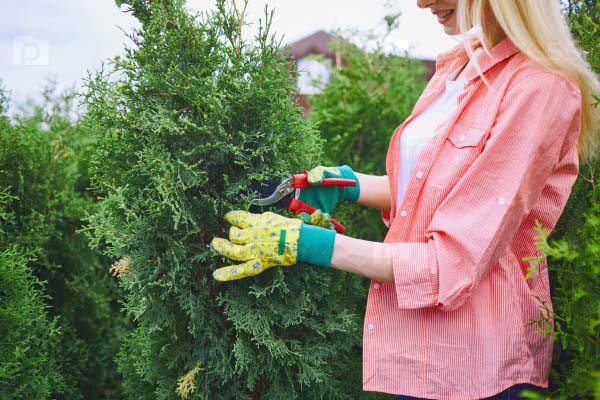

Why cut a thuja?
Depending on the variety, the thuja can be in the shape of a ball, column or pyramid, so in most cases it is not necessary to form the crown of a coniferous tree. Why, then, is the thuja cut off?
- To improve the appearance of the tree. During pruning of an evergreen tree, dried, diseased and insect-affected branches or their parts are removed from the crown. If the branch is still alive, and the affected area is very small, a hand is drawn along the branch and the dried needles are removed. In some cases, instead of the affected needles, healthy ones grow on the shoot, and there is no need to remove it.
Important! Sick branches should be cut off immediately after they appear. This will help prevent infection of the entire tree.
- For shape correction... Too long shoots are cut off, which stand out noticeably from the crown. And also during pruning, the top is removed if it has dried out or has become too elongated. As a result of cutting off the top, healthy shoots will receive more useful elements, and the tree activates the growth of lateral shoots, which will give the thuja even more splendor.
- To prevent pest attacks and the best breathability.
When is the best time to prune - in spring or autumn?
The coniferous tree tolerates pruning well at any time of the year. Some varieties are cut 3 times a year. Because of this, we can say that the main thing in the cultivation of the crown is not the time of the pruning, but its consistency and correctness. Therefore, pruning of thuja can be carried out in the fall.
Timing of pruning thuja in the fall
There is no specific time frame for manipulation aimed at thinning or forming thuja. The main conditions in choosing a suitable day for pruning are cloudy dry weather and temperatures above +4 С... If this rule is not followed, the wounds will heal for a long time, and the needles near them will turn yellow.
How to properly cut thuja in the fall - instructions and diagram
Pruning thuja is a very scrupulous business, therefore, in order for it to be useful for the plant, the manipulation must be carried out especially carefully.
Thuja is cut as follows:
- Dry, diseased, sun-damaged or insect-damaged shoots are removed from the crown.
- Some of the branches are removed inside the bush. Thanks to thinning, breathability is significantly improved. And also manipulation is a preventive measure against attack by pests.
- To promote growth in width, cut off part of the top. To achieve the formation of a tree in the form of a ball, removing the branches protruding from the crown will help.
- In order to maintain the chosen shape, part of last year's shoots is cut from the crown. Please note that you cannot cut the tree too much - it can lose its decorative beauty for a long time.
- If it was not possible to cut the thuja on time, the manipulation is transferred to spring or summer. In several approaches, the tree is freed from frozen and unnecessary branches.
The most common schemes for cutting thuja are: topiary, spherical, spiral.
Topiary haircut represents the formation of a crown in the form of any figure or object. In specialty stores, metal forms of various shapes are sold, which must be installed over the plant. After some time, the thuja will fill the entire free space of the form. Those shoots that will stick out should be cut off.
Similarly, a crown is formed in the form ball or spiral: all excess shoots are gradually removed until the tree takes on the desired shape.
According to experienced gardeners, crown formation is best done a year later, after thinning. During this time, the tree will fully recover and transfer large-scale formative pruning without problems.
Video: how to crop the autumn, spring or summer
Leaving after pruning, feeding
For a week after sanitary or formative pruning, you need to monitor the condition of the thuja, since after active intervention, the plant weakens and is highly exposed to diseases and the attack of a false scale insect and aphids. In the event of a problem, the thuja is sprayed with special preparations.
Immediately after the end of the cultivation of the crown, the thuja is abundantly watered and fed. Complex mixtures for conifers, diluted manure, green manure are used as fertilizers.
How to fertilize conifers in autumn
Like all plants, conifers need fertilizers for rapid growth: such top dressing will keep your plantings decorative throughout their life. Of course, you can use universal fertilizers for conifers, but preference should be given to special ones. You will learn about the composition and methods of using the most effective of them on this page.
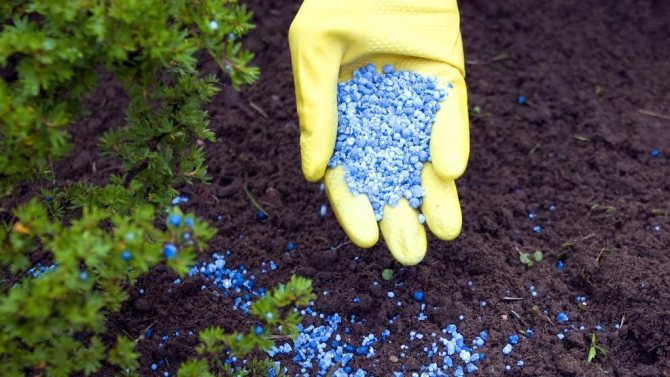

General requirements for fertilization of conifers
Many amateur gardeners are interested in how and what to feed the conifers. Some are of the opinion that they do not need fertilization at all, because most conifers grow in forest thickets and no one cares for them. And they grow for a very long time. But experienced gardeners are strongly advised to feed the plants in order to prevent diseases. It is especially important to apply fertilizers for young plants that have a fragile root system.
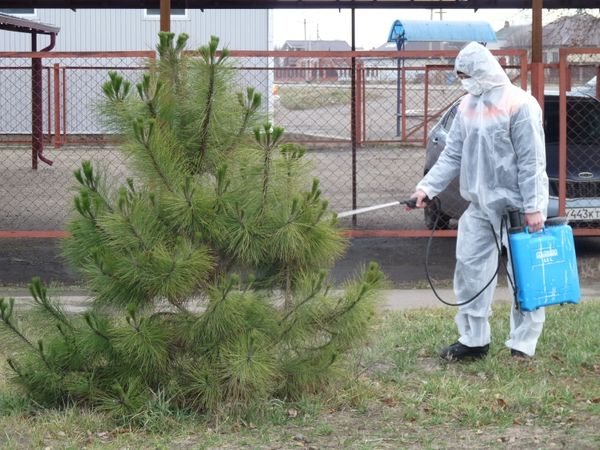

Common diseases
If frequent thaws occur in the winter season, they can lead to the development of fungal diseases on spruce trees. If you notice that the needles have become darker or have begun to die off, this means that the tree is infected with a fungus. This disease can cause twigs to die off.
In order to minimize the possibility of the appearance of fungus on a tree, it is better to give preference to varieties that are highly resistant to diseases when buying seedlings. If it was not possible to avoid the disease of the tree, then the method of treatment with fungicides can be used for treatment.
Do I need to feed thuja and junipers if they do not turn yellow
For successful rooting and adaptation in a new place of growth, thuja seedlings are fed immediately upon planting. Also, during the first few years, you will need to regularly apply organic or mineral fertilizers to help form a healthy skeleton and a lush crown.
Coniferous shrubs and trees will be able to extract all the necessary substances for normal growth from the soil on their own in adulthood. But even then, you should periodically feed it so that the evergreen beauties do not suffer from the natural depletion of the soil.
Let's talk about the fertilization schedule. Timeliness, dosage and the correct method of feeding are important conditions.
Diseases and pests
| Schütte Symptoms:
Treatment:
|
| Bacteriosis Symptoms:
Treatment:
|
| Hermes Symptoms:
Treatment:
|



